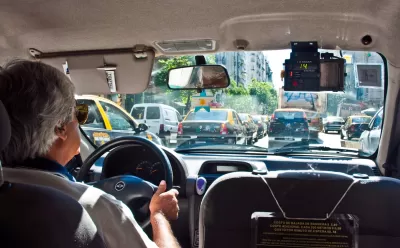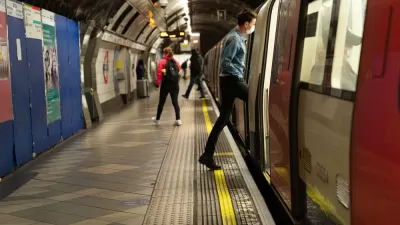Research suggests maximizing airflow during shared car rides vastly reduces the risk of transmission.

As public health officials warned of the dangers of congregating in enclosed spaces during the COVID-19 pandemic, Americans took refuge in one of our favorite private spaces: cars. Although traveling by car may put you at lower risk of transmission than, say, a crowded bus, private vehicles still carry their own risks of infection, reports Emily Anthes. "They are small, tightly sealed spaces that make social distancing impossible and trap the tiny, airborne particles, or aerosols, that can transmit the coronavirus."
A new study maps the patterns of airflow inside a car and suggests that "opening certain windows can create air currents that could help keep both riders and drivers safe from infectious diseases."
"Unsurprisingly, they found that the ventilation rate was lowest when all four windows were closed. In this scenario, roughly 8 to 10 percent of aerosols exhaled by one of the car’s occupants could reach the other person, the simulation suggested. When all the windows were completely open, on the other hand, ventilation rates soared, and the influx of fresh air flushed many of the airborne particles out of the car; just 0.2 to 2 percent of the simulated aerosols traveled between driver and passenger."
When opening all the windows isn't an option, the study's authors recommend opening the windows opposite each occupant to create the most effective air flow.
FULL STORY: How to (Literally) Drive the Coronavirus Away

Planetizen Federal Action Tracker
A weekly monitor of how Trump’s orders and actions are impacting planners and planning in America.

Chicago’s Ghost Rails
Just beneath the surface of the modern city lie the remnants of its expansive early 20th-century streetcar system.

San Antonio and Austin are Fusing Into one Massive Megaregion
The region spanning the two central Texas cities is growing fast, posing challenges for local infrastructure and water supplies.

Since Zion's Shuttles Went Electric “The Smog is Gone”
Visitors to Zion National Park can enjoy the canyon via the nation’s first fully electric park shuttle system.

Trump Distributing DOT Safety Funds at 1/10 Rate of Biden
Funds for Safe Streets and other transportation safety and equity programs are being held up by administrative reviews and conflicts with the Trump administration’s priorities.

German Cities Subsidize Taxis for Women Amid Wave of Violence
Free or low-cost taxi rides can help women navigate cities more safely, but critics say the programs don't address the root causes of violence against women.
Urban Design for Planners 1: Software Tools
This six-course series explores essential urban design concepts using open source software and equips planners with the tools they need to participate fully in the urban design process.
Planning for Universal Design
Learn the tools for implementing Universal Design in planning regulations.
planning NEXT
Appalachian Highlands Housing Partners
Mpact (founded as Rail~Volution)
City of Camden Redevelopment Agency
City of Astoria
City of Portland
City of Laramie





























